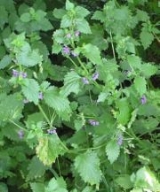
Ballota
Encyclopedia
Ballota is a genus
of about 35 species
of flowering plant
s in the family
Lamiaceae
, native
to temperate regions of Europe
, north Africa
and western Asia
, with the highest diversity
in the Mediterranean region. The type species
for the genus is Ballota nigra.
Ballota is paraphyletic and will eventually be re-circumscribed
. It is closely related to Moluccella
and Marrubium
. Some of its species had previously been placed in Marrubium.
Ballota species are used as food plants by the larva
e of some Lepidoptera
including Coleophora
case-bearers: C. ballotella, C. lineolea (which has been recorded on B. nigra) and C. ochripennella.
Selected species
Genus
In biology, a genus is a low-level taxonomic rank used in the biological classification of living and fossil organisms, which is an example of definition by genus and differentia...
of about 35 species
Species
In biology, a species is one of the basic units of biological classification and a taxonomic rank. A species is often defined as a group of organisms capable of interbreeding and producing fertile offspring. While in many cases this definition is adequate, more precise or differing measures are...
of flowering plant
Flowering plant
The flowering plants , also known as Angiospermae or Magnoliophyta, are the most diverse group of land plants. Angiosperms are seed-producing plants like the gymnosperms and can be distinguished from the gymnosperms by a series of synapomorphies...
s in the family
Family (biology)
In biological classification, family is* a taxonomic rank. Other well-known ranks are life, domain, kingdom, phylum, class, order, genus, and species, with family fitting between order and genus. As for the other well-known ranks, there is the option of an immediately lower rank, indicated by the...
Lamiaceae
Lamiaceae
The mints, taxonomically known as Lamiaceae or Labiatae, are a family of flowering plants. They have traditionally been considered closely related to Verbenaceae, but in the 1990s, phylogenetic studies suggested that many genera classified in Verbenaceae belong instead in Lamiaceae...
, native
Indigenous (ecology)
In biogeography, a species is defined as native to a given region or ecosystem if its presence in that region is the result of only natural processes, with no human intervention. Every natural organism has its own natural range of distribution in which it is regarded as native...
to temperate regions of Europe
Europe
Europe is, by convention, one of the world's seven continents. Comprising the westernmost peninsula of Eurasia, Europe is generally 'divided' from Asia to its east by the watershed divides of the Ural and Caucasus Mountains, the Ural River, the Caspian and Black Seas, and the waterways connecting...
, north Africa
Africa
Africa is the world's second largest and second most populous continent, after Asia. At about 30.2 million km² including adjacent islands, it covers 6% of the Earth's total surface area and 20.4% of the total land area...
and western Asia
Asia
Asia is the world's largest and most populous continent, located primarily in the eastern and northern hemispheres. It covers 8.7% of the Earth's total surface area and with approximately 3.879 billion people, it hosts 60% of the world's current human population...
, with the highest diversity
Biodiversity
Biodiversity is the degree of variation of life forms within a given ecosystem, biome, or an entire planet. Biodiversity is a measure of the health of ecosystems. Biodiversity is in part a function of climate. In terrestrial habitats, tropical regions are typically rich whereas polar regions...
in the Mediterranean region. The type species
Type species
In biological nomenclature, a type species is both a concept and a practical system which is used in the classification and nomenclature of animals and plants. The value of a "type species" lies in the fact that it makes clear what is meant by a particular genus name. A type species is the species...
for the genus is Ballota nigra.
Ballota is paraphyletic and will eventually be re-circumscribed
Circumscription (taxonomy)
In taxonomy, circumscription is the definition of the limits of a taxonomic group of organisms. One goal of taxonomy is to achieve a stable circumscription for every taxonomic group. Achieving stability can be simple or difficult....
. It is closely related to Moluccella
Moluccella
Moluccella is a genus of four species of annual and short-lived perennial plants native to northwestern India to the Mediterranean. They are tall, upright, branched plants to 1 meter or more with toothed leaves and small white fragrant flowers.Species...
and Marrubium
Marrubium
Marrubium is a genus of about 40 species of flowering plants in the family Lamiaceae, native to temperate regions of Europe and Asia.Selected species*Marrubium alternidens*Marrubium alysson...
. Some of its species had previously been placed in Marrubium.
Ballota species are used as food plants by the larva
Larva
A larva is a distinct juvenile form many animals undergo before metamorphosis into adults. Animals with indirect development such as insects, amphibians, or cnidarians typically have a larval phase of their life cycle...
e of some Lepidoptera
Lepidoptera
Lepidoptera is a large order of insects that includes moths and butterflies . It is one of the most widespread and widely recognizable insect orders in the world, encompassing moths and the three superfamilies of butterflies, skipper butterflies, and moth-butterflies...
including Coleophora
Coleophora
Coleophora is a very large genus of moths of the family Coleophoridae. It contains some 1,350 described species. The genus is represented on all continents, but the majority are found in the Nearctic and Palaearctic regions...
case-bearers: C. ballotella, C. lineolea (which has been recorded on B. nigra) and C. ochripennella.
Selected species
- Ballota acetabulosa
- Ballota frutescens
- Ballota hirsutaBallota hirsutaBallota hirsuta is a plant of the family Lamiaceae, native to the western Mediterranean region, mostly abundant in Spain and Portugal. It is also native to Morocco and Italy.-External links:*...
- Ballota nigra - Black Horehound
- Ballota pseudodictamnus

